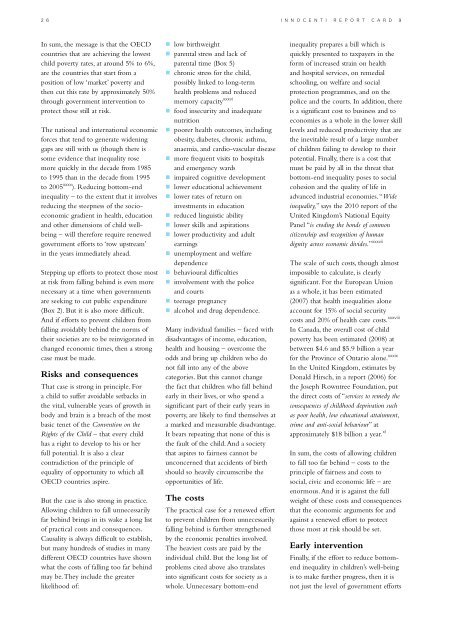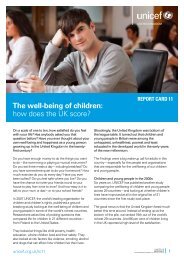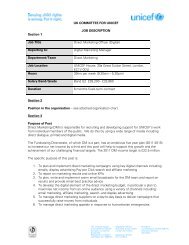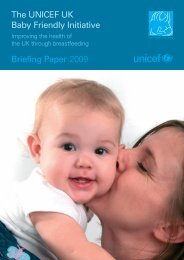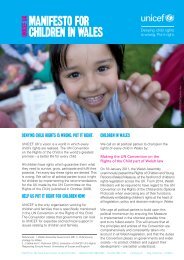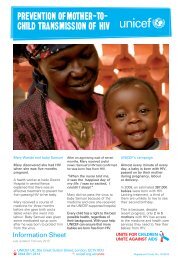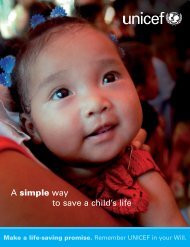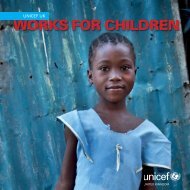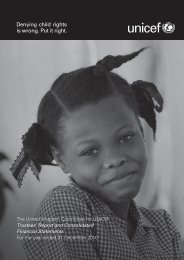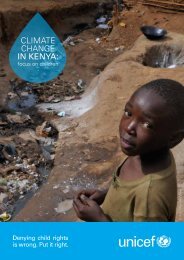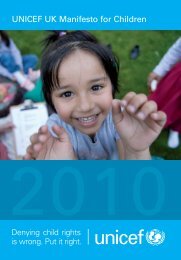The children left behind - Innocenti Research Centre
The children left behind - Innocenti Research Centre
The children left behind - Innocenti Research Centre
You also want an ePaper? Increase the reach of your titles
YUMPU automatically turns print PDFs into web optimized ePapers that Google loves.
2 6 I n n o c e n t i R e p o r t C a r d 9<br />
In sum, the message is that the OECD<br />
countries that are achieving the lowest<br />
child poverty rates, at around 5% to 6%,<br />
are the countries that start from a<br />
position of low ‘market’ poverty and<br />
then cut this rate by approximately 50%<br />
through government intervention to<br />
protect those still at risk.<br />
<strong>The</strong> national and international economic<br />
forces that tend to generate widening<br />
gaps are still with us (though there is<br />
some evidence that inequality rose<br />
more quickly in the decade from 1985<br />
to 1995 than in the decade from 1995<br />
to 2005 xxxv ). Reducing bottom-end<br />
inequality – to the extent that it involves<br />
reducing the steepness of the socioeconomic<br />
gradient in health, education<br />
and other dimensions of child wellbeing<br />
– will therefore require renewed<br />
government efforts to ‘row upstream’<br />
in the years immediately ahead.<br />
Stepping up efforts to protect those most<br />
at risk from falling <strong>behind</strong> is even more<br />
necessary at a time when governments<br />
are seeking to cut public expenditure<br />
(Box 2). But it is also more difficult.<br />
And if efforts to prevent <strong>children</strong> from<br />
falling avoidably <strong>behind</strong> the norms of<br />
their societies are to be reinvigorated in<br />
changed economic times, then a strong<br />
case must be made.<br />
Risks and consequences<br />
That case is strong in principle. For<br />
a child to suffer avoidable setbacks in<br />
the vital, vulnerable years of growth in<br />
body and brain is a breach of the most<br />
basic tenet of the Convention on the<br />
Rights of the Child – that every child<br />
has a right to develop to his or her<br />
full potential. It is also a clear<br />
contradiction of the principle of<br />
equality of opportunity to which all<br />
OECD countries aspire.<br />
But the case is also strong in practice.<br />
Allowing <strong>children</strong> to fall unnecessarily<br />
far <strong>behind</strong> brings in its wake a long list<br />
of practical costs and consequences.<br />
Causality is always difficult to establish,<br />
but many hundreds of studies in many<br />
different OECD countries have shown<br />
what the costs of falling too far <strong>behind</strong><br />
may be. <strong>The</strong>y include the greater<br />
likelihood of:<br />
low birthweight<br />
parental stress and lack of<br />
parental time (Box 5)<br />
chronic stress for the child,<br />
possibly linked to long-term<br />
health problems and reduced<br />
memory capacity xxxvi<br />
food insecurity and inadequate<br />
nutrition<br />
poorer health outcomes, including<br />
obesity, diabetes, chronic asthma,<br />
anaemia, and cardio-vascular disease<br />
more frequent visits to hospitals<br />
and emergency wards<br />
impaired cognitive development<br />
lower educational achievement<br />
lower rates of return on<br />
investments in education<br />
reduced linguistic ability<br />
lower skills and aspirations<br />
lower productivity and adult<br />
earnings<br />
unemployment and welfare<br />
dependence<br />
behavioural difficulties<br />
involvement with the police<br />
and courts<br />
teenage pregnancy<br />
alcohol and drug dependence.<br />
Many individual families – faced with<br />
disadvantages of income, education,<br />
health and housing – overcome the<br />
odds and bring up <strong>children</strong> who do<br />
not fall into any of the above<br />
categories. But this cannot change<br />
the fact that <strong>children</strong> who fall <strong>behind</strong><br />
early in their lives, or who spend a<br />
significant part of their early years in<br />
poverty, are likely to find themselves at<br />
a marked and measurable disadvantage.<br />
It bears repeating that none of this is<br />
the fault of the child. And a society<br />
that aspires to fairness cannot be<br />
unconcerned that accidents of birth<br />
should so heavily circumscribe the<br />
opportunities of life.<br />
<strong>The</strong> costs<br />
<strong>The</strong> practical case for a renewed effort<br />
to prevent <strong>children</strong> from unnecessarily<br />
falling <strong>behind</strong> is further strengthened<br />
by the economic penalties involved.<br />
<strong>The</strong> heaviest costs are paid by the<br />
individual child. But the long list of<br />
problems cited above also translates<br />
into significant costs for society as a<br />
whole. Unnecessary bottom-end<br />
inequality prepares a bill which is<br />
quickly presented to taxpayers in the<br />
form of increased strain on health<br />
and hospital services, on remedial<br />
schooling, on welfare and social<br />
protection programmes, and on the<br />
police and the courts. In addition, there<br />
is a significant cost to business and to<br />
economies as a whole in the lower skill<br />
levels and reduced productivity that are<br />
the inevitable result of a large number<br />
of <strong>children</strong> failing to develop to their<br />
potential. Finally, there is a cost that<br />
must be paid by all in the threat that<br />
bottom-end inequality poses to social<br />
cohesion and the quality of life in<br />
advanced industrial economies. “Wide<br />
inequality,” says the 2010 report of the<br />
United Kingdom’s National Equity<br />
Panel “is eroding the bonds of common<br />
citizenship and recognition of human<br />
dignity across economic divides.” xxxvii<br />
<strong>The</strong> scale of such costs, though almost<br />
impossible to calculate, is clearly<br />
significant. For the European Union<br />
as a whole, it has been estimated<br />
(2007) that health inequalities alone<br />
account for 15% of social security<br />
costs and 20% of health care costs. xxxviii<br />
In Canada, the overall cost of child<br />
poverty has been estimated (2008) at<br />
between $4.6 and $5.9 billion a year<br />
for the Province of Ontario alone. xxxix<br />
In the United Kingdom, estimates by<br />
Donald Hirsch, in a report (2006) for<br />
the Joseph Rowntree Foundation, put<br />
the direct costs of “services to remedy the<br />
consequences of childhood deprivation such<br />
as poor health, low educational attainment,<br />
crime and anti-social behaviour” at<br />
approximately $18 billion a year. xl<br />
In sum, the costs of allowing <strong>children</strong><br />
to fall too far <strong>behind</strong> – costs to the<br />
principle of fairness and costs to<br />
social, civic and economic life – are<br />
enormous. And it is against the full<br />
weight of these costs and consequences<br />
that the economic arguments for and<br />
against a renewed effort to protect<br />
those most at risk should be set.<br />
Early intervention<br />
Finally, if the effort to reduce bottomend<br />
inequality in <strong>children</strong>’s well-being<br />
is to make further progress, then it is<br />
not just the level of government efforts


